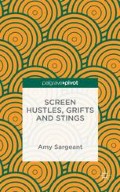Abstract
Chapters 3 mostly concerned with the television series, Hustle, representing a bowdlerised version of the con. Here, each member of a crew of con artists plays a designated role, and there is jockeying for position in the surrogate family. An honest man has nothing to fear from these bandits, and marks are repeatedly hoisted by their own petard.
Access this chapter
Tax calculation will be finalised at checkout
Purchases are for personal use only
Preview
Unable to display preview. Download preview PDF.
Notes
Edgar Allan Poe, ‘Diddling Considered as One of the Exact Sciences’ [1843], The Complete Works of Edgar Allan Poe, v. 5 (New York: AMS Press Inc., 1965), p. 211.
Joel Chandler Harris, Marcus Croach (ed.), Brer Rabbit (London: Pelham Books, 1977), p. 98.
Margaret Blount, Animal Land: The Creatures of Children’s Fiction (London: Hutchinson, 1974), pp. 38–39.
An Extract from Mr. Locke’s Thoughts Concerning Education’, R. Wynne (ed.), Essays on Education by Milton, Locke, and the Authors of the Spectator [1761] (Bristol: Thoemmes Press, 1995), p. 37
Martin Kemp, Christ to Coke: How Image Becomes Icon (Oxford: Oxford University Press, 2012), p. 6;
see also, Kenneth Clark, Animals and Men (London: Thames and Hudson, 1977), p. 101.
For a discussion of Ritchie’s films as ‘faux’, see Steve Chibnall, ‘Travels in Ladland’: The British Gangster Film Cycle 1998–2001’, Robert Murphy (ed.), The British Cinema Book (London: BFI, 2001), pp. 281–291.
See Peter Russell and Senta Slingerland (eds.), Game Changers: The Evolution of Advertising (Cologne: Taschen, 2013), p. 54.
Amy Sargeant, British Cinema: A Critical History (London: BFI, 2005), p. 331; Jaime Murray was cast in ads for Debenhams in Autumn 2006.
See Jeffrey Kurland, ‘Why Design?’ in Deborah Nadoolman Landis (ed.), Hollywood Costume (London: V&Amp;A Publishing, 2012), pp. 272–279; pp. 278–279.
Mark Twain, Pudd’nhead Wilson [1894], (London: Penguin, 1986), pp. 310 and 312.
Eric Hobsbawm, Bandits (London: Weidenfeld and Nicolson, 1969), p. 21.
Lucy Mangan, in her BBC R4 series in August 2014, discussed ‘The £1,000,00 Bank-note’ and the 1880s Gold Rush with the economist Andrew Sentence precisely as a matter of a character using the note to build confidence. See Mark Twain, The American Claimant and other Stories and Sketches [1897], (New York: AMS Press Inc., 1971) and Lindberg, The Confidence Man, p. 216.
Author information
Authors and Affiliations
Copyright information
© 2016 Amy Sargeant
About this chapter
Cite this chapter
Sargeant, A. (2016). Aesop and Brer Rabbit. In: Screen Hustles, Grifts and Stings. Palgrave Pivot, London. https://doi.org/10.1057/9781137466891_4
Download citation
DOI: https://doi.org/10.1057/9781137466891_4
Publisher Name: Palgrave Pivot, London
Print ISBN: 978-1-137-46688-4
Online ISBN: 978-1-137-46689-1
eBook Packages: Literature, Cultural and Media StudiesLiterature, Cultural and Media Studies (R0)

